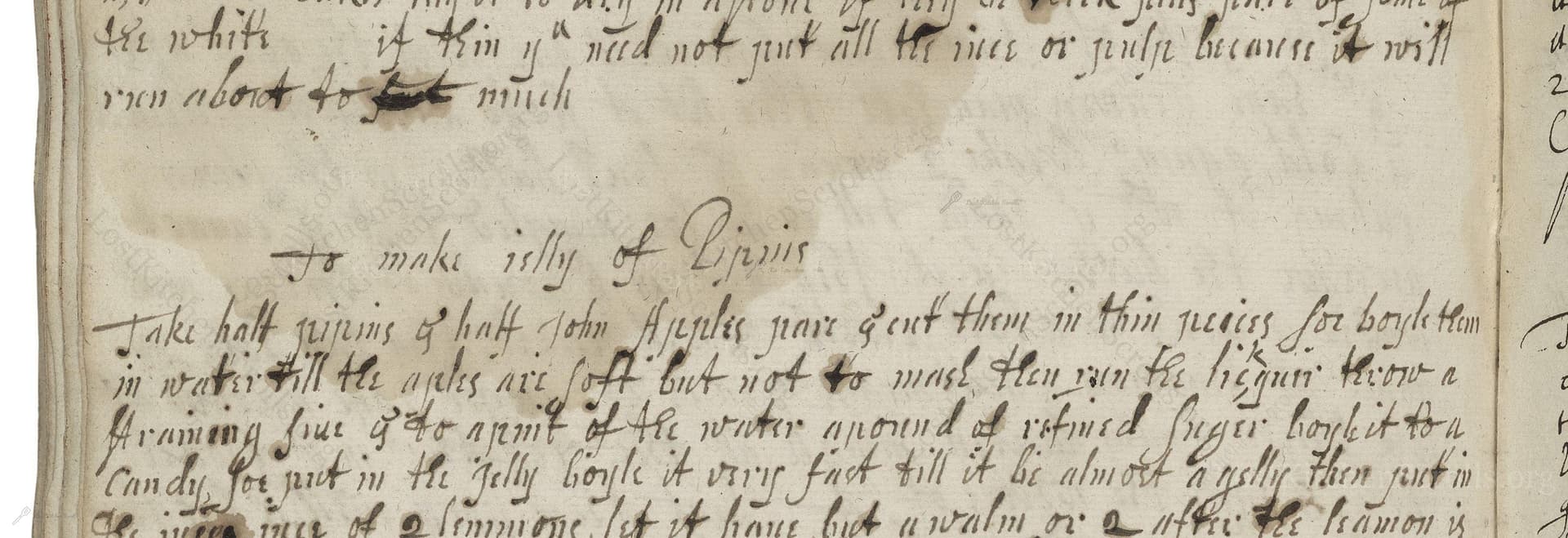To Make Jelly Of Pippins
From the treasured pages of Cookbook with various recipes
Unknown Author

To Make Jelly Of Pippins
"Take half quins & half John Apples boyl them in water till the aples are soft but not to much, then run the liquor thru a straining sive & to a pint of the water a pound of refined sugar boyl it to a Candy heigth, put in the jelly boyl it very fast till it be almost a gelly then put in some juice of a lemmon, let it have the necer juice of 2 lemmons, let it ly in it, you may boyl orring or lemmon rind if you please or yf like"
Note on the Original Text
The recipe is written in dense, flowing prose, omitting exact measures or temperatures—it relies on the cook's intuition and tactile knowledge of the setting point ('boil to a Candy heigth'). Words such as 'boyl' (boil), 'quins' (quinces), and 'gelly' (jelly) demonstrate the variable orthography of the period, before English spelling was standardized. Ingredient amounts are imprecise, and the cook is left to judge by the look and feel of the mixture; this was common in manuscript cookery, which assumed some baseline expertise. The directions are both incomplete by modern standards and highly flexible, inviting the cook to adapt, embellish, or refine as needed.

Title
Cookbook with various recipes (1684)
You can also click the book image above to peruse the original tome
Writer
Unknown
Era
1684
Publisher
Unknown
Background
A tantalizing taste of late seventeenth-century cookery, this charming volume gathers together the flavors, techniques, and secret recipes that delighted English households of yore. Perfect for gastronomic adventurers seeking to recreate the elegance and intrigue of historical feasts.
Kindly made available by
Folger Shakespeare Library
This jelly recipe hails from a manuscript dating between 1678 and 1689, a time when English kitchens revelled in preserving seasonal fruit. Jellies like this were treasured both for their bright, jewel-like appearance and their luscious sweetness—a symbol of both wealth and domestic skill. Quinces and apples were common in period orchards, and the practice of preserving them with sugar (a luxury ingredient) reflects the status of the household. Recipes from this period were typically handed down within families or compiled in manuscript 'receipt books' by learned women overseeing household affairs.

Cooks of the late 17th century would have used large copper or brass kettles for boiling fruit, and perhaps linen or muslin straining bags to extract a clear juice. Straining sieves (often made of horsehair or linen), wooden spoons for stirring, and open hearths provided the heat. Jellies would likely have been poured into ceramic or glass molds for an attractive presentation, or simple earthenware pots for storage.
Prep Time
30 mins
Cook Time
1 hr
Servings
4
We've done our best to adapt this historical recipe for modern kitchens, but some details may still need refinement. We warmly welcome feedback from fellow cooks and culinary historians — your insights support the entire community!
Ingredients
- 1 lb quince (substitute: any aromatic, tart apple if quince unavailable)
- 1 lb tart green apples (such as Granny Smith)
- approximately 4 cups water (enough to cover the fruit)
- 2 lbs refined white sugar
- Juice of 2 lemons, freshly squeezed
- Optional: strips of lemon or orange rind
Instructions
- To recreate this delightful 17th-century apple jelly, begin by combining equal weights of quinces and tart green apples (Granny Smiths make a fine substitute for John Apples).
- Cut the fruit into quarters (remove seeds but keep peels), then simmer in enough water to just cover the fruit, until the apples are tender but not falling apart—about 30 to 40 minutes.
- Strain through a fine mesh sieve or cheesecloth to extract the clear juice.
- Measure out 2 cups of this juice, and for each 2 cups, add 2 cups (1 lb) of refined white sugar.
- Bring this mixture to a brisk boil and cook rapidly until it reaches the 'candy' or setting stage (about 219–223°F, or until it thickens when dripped onto a cold plate).
- Stir in the strained juice of 2 fresh lemons, plus, if desired, a strip or two of lemon or orange rind for a zesty aroma.
- Let the rinds infuse for a few minutes before removing them.
- Pour the hot jelly into sterilized jars, seal, and let cool until set.
Estimated Calories
190 per serving
Cooking Estimates
Preparing and cooking the jelly takes about an hour and a half. This recipe makes about 4 small jars (servings), with each serving containing just under 200 calories mainly from the sugar used.
As noted above, we have made our best effort to translate and adapt this historical recipe for modern kitchens, taking into account ingredients nowadays, cooking techniques, measurements, and so on. However, historical recipes often contain assumptions that require interpretation.
We'd love for anyone to help improve these adaptations. Community contributions are highly welcome. If you have suggestions, corrections, or cooking tips based on your experience with this recipe, please share them below.
Join the Discussion
Rate This Recipe
Dietary Preference
Main Ingredients
Culinary Technique

Den Bockfisch In Einer Fleisch Suppen Zu Kochen
This recipe hails from a German manuscript cookbook compiled in 1696, a time whe...

Die Grieß Nudlen Zumachen
This recipe comes from a rather mysterious manuscript cookbook, penned anonymous...

Ein Boudain
This recipe comes from an anonymous German-language manuscript cookbook from 169...

Ein Gesaltzen Citroni
This recipe, dating from 1696, comes from an extensive anonymous German cookbook...
Browse our complete collection of time-honored recipes



